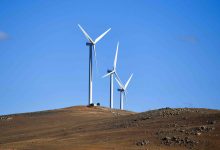A new scientific study has become the latest to debunk the theory that infrasound generated by wind farms can be harmful to human health, finding no evidence at all for the existence of what has become known as wind turbine syndrome.
Infrasound, as the University of Sydney’s Simon Chapman explains here, is sound below 20Hz, which is generally inaudible and which can be man-made – wind turbines, power stations, road traffic – or generated from natural sources like waves and, you guessed it, wind.
In the relatively short history of wind generation, and peaking in the 2010s, infrasound from spinning wind turbines has been blamed for a broad range of mainly anecdotal ill-health effects on both humans and animals, ranging from dizzy spells and sleep deprivation to birth defects in lambs.
Numerous scientific and academic studies have disproved these claims, including a 2014 MIT study that found living close to wind farms does not harm human health, but rather causes annoyance – in certain people.
Another in 2013 by the Association of Australian Acoustical Consultants (AAAC) found that infrasound levels from turbines are usually lower, and definitely no higher, than what we are already regularly exposed to in our natural environment and even from our own bodies, including the human heartbeat.
The AAAC study also mentions that some wind turbines produce tones that are audible for humans and although those may be irritating, they too do not pose any direct health risk.
New “conclusive” scientific evidence
The new study conducted by the Woolcock Institute of Medical Research, a University of Sydney affiliated specialist in the prevention and treatment of sleep and respiratory disorders, measured the effects of pure infrasound on human sleep in experimental conditions.
The researchers – led by lead investigator Associate Professor Nathaniel Marshall – enlisted 37 healthy “noise sensitive” adults for three, three-night stays in the sound-proof Woolcock sleep lab.
There, the test subjects were exposed to either wind turbine simulated infrasound, no sound, or traffic noise. Participants were “blinded” as to whether infrasound or no sound was being played as infrasound is inaudible.
The results of the study, published this month in the Environmental Health Perspectives journal, found “no evidence” that 72 hours of exposure simulated wind turbine infrasound in double-blind conditions caused any adverse physiological or psychological effects.
“None of the 36 people exposed to infrasound developed what could be described as [wind turbine syndrome],” the report says.
Our researchers have confirmed that the so-called ‘silent sound’ that emanates from wind farms does not harm human health. https://t.co/nyB4ISa8aM
— Woolcock Institute of Medical Research (@Woolcockmedical) March 22, 2023
“We’ve been able to show conclusively that the infrasound generated by wind turbines doesn’t make you dizzy or nauseous, doesn’t impact heart health or mental health, or impact on sleep,” says lead study investigator Associate Professor Nathaniel Marshall.
“Uncertainty around the syndrome has cast a shadow over the future of wind farms as a clean energy source, so it’s great to get such a clear result from the study.”
Of course, this is one relatively small study and, as the researchers themselves note, has its limitations.
But as the report also points out, it is also the first to measure the effects of pure infrasound in experimental conditions on human sleep.
“People who suffer from WTS [wind turbine syndrome] report that their symptoms begin quickly when they are exposed to infrasound from wind turbines and are then sustained.
“Our scientifically robust study provides evidence to address this claim.
“This study suggests that the infrasound component of [wind turbine noise] is unlikely to be a cause of ill-health or sleep disruption, although this observation should be independently replicated,” the report concludes.










